What is OperativeDevice?
OperativeDevice is an adware. Adware can make big problem to your computer. Adware sometimes named ‘ad-supported’ software is harmful application which shows a large amount of adverts in form of pop-up windows, discount offers, banners or even fake alerts on the web browser. Adware can seriously affect your privacy, your computer’s performance and security. Adware software can be installed onto your machine without your knowledge.

Unwanted ads
The worst is, adware has the ability to gather and transmit user data without your permission. Adware software be able to track information about webpages visited, web-browser and system information, and your machine IP address.
How does OperativeDevice get on your computer
Adware come along with various freeware. This is certainly not an honest way to get added onto your machine. To avoid infecting of your machine and side effects in the form of numerous pop-ups and/or unwanted advertisements, you should always carefully read the Terms of Use and the Software license. Additionally, always select Manual, Custom or Advanced setup method. This allows you to disable the setup of unnecessary and often harmful apps.
Threat Summary
| Name | OperativeDevice, Operative Device 1.0 app |
| Type | adware software, PUP (potentially unwanted program), popup ads, popups, pop up virus |
| Symptoms |
|
| Removal | OperativeDevice removal guide |
How to remove OperativeDevice
There are a few ways that can be used to remove OperativeDevice adware. But, not all PUPs such as this adware can be completely deleted using only manual ways. In most cases you’re not able to remove any adware utilizing standard Mac options. In order to remove adware you need complete a few manual steps and use reliable removal utilities. Most IT security experts states that MalwareBytes Anti Malware tool is a right choice. The free application is able to search for and remove adware software from your MAC and return your web browser settings to defaults.
To remove OperativeDevice, perform the steps below:
- Manual OperativeDevice removal
- Automatic Removal of OperativeDevice adware
- How to stay safe online
- Finish words
Manual OperativeDevice removal
First of all, try to get rid of OperativeDevice adware manually; to do this, follow the steps below. Of course, manual removal of adware software requires more time and may not be suitable for those who are poorly versed in computer settings. In this case, we suggest that you scroll down to the section that describes how to get rid of adware using free tools.
Uninstall OperativeDevice related applications through the Finder
We recommend that you begin the MAC system cleaning procedure by checking the list of installed applications and delete all unknown or suspicious apps. This is a very important step, as mentioned above, very often the malicious applications such as adware software and hijacker infections may be bundled with free programs. Delete the unwanted apps can get rid of the annoying advertisements or internet browser redirect.
Open Finder and click “Applications” similar to the one below.

You will see a list of software installed on your Apple Mac. We recommend to pay maximum attention to the program you installed last. Most probably, it’s the OperativeDevice . If you’re in doubt, you can always check the program by doing a search for her name in Google, Yahoo or Bing. After the program which you need to uninstall is found, simply right click on its name, and select “Move to Trash”.
Don’t forget, select Finder, then “Empty Trash”.
Delete OperativeDevice adware software from Safari
If you find that Safari browser settings such as default search engine, new tab page and homepage having been modified by OperativeDevice , then you may revert back your settings, via the reset internet browser procedure.
Run Safari internet browser. Next, choose Preferences from the Safari menu.
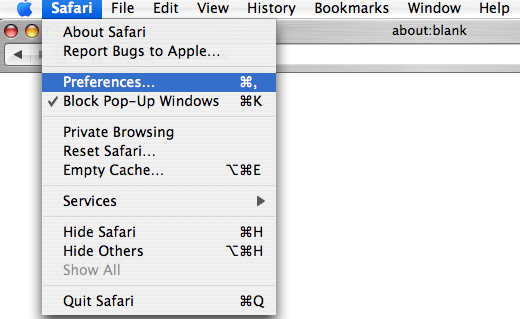
First, click the “Security” tab. Here, select “Block pop-up windows”. It will block some types of popups.
Now, click the “Extensions” icon. Look for questionable add-ons on left panel, choose it, then click the “Uninstall” button. Most important to remove all suspicious extensions from Safari.
Once complete, check your startpage and search engine settings. Click “General” icon. Make sure that the “Homepage” field contains the website you want or is empty.
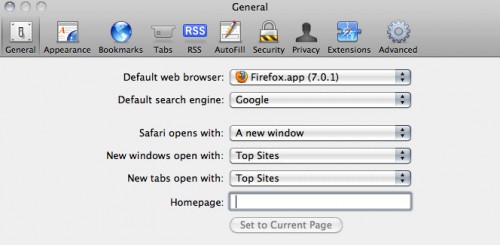
Make sure that the “Search engine” setting shows your preferred search engine. In some versions of Safari, this setting is in the “Search” tab.
Get rid of OperativeDevice from Firefox by resetting web-browser settings
Resetting your Firefox is basic troubleshooting step for any issues with your web-browser program, including unwanted ads. Essential information like bookmarks, browsing history, passwords, cookies, auto-fill data and personal dictionaries will not be removed.
Start the Firefox and press the menu button (it looks like three stacked lines) at the top right of the web browser screen. Next, click the question-mark icon at the bottom of the drop-down menu. It will show the slide-out menu.
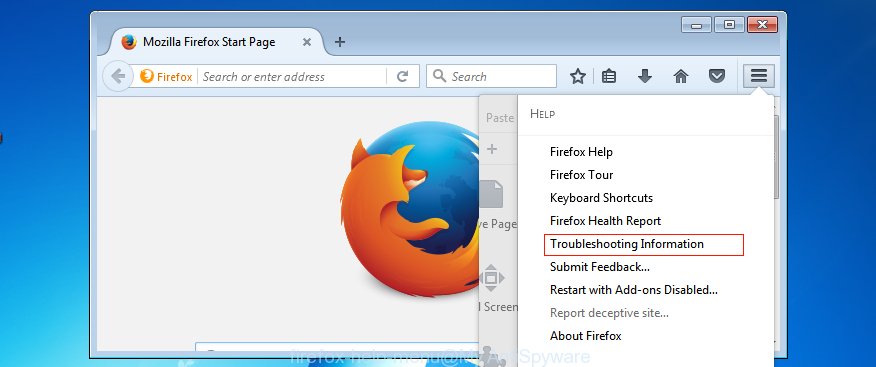
Select the “Troubleshooting information”. If you are unable to access the Help menu, then type “about:support” in your address bar and press Enter. It bring up the “Troubleshooting Information” page as displayed on the image below.
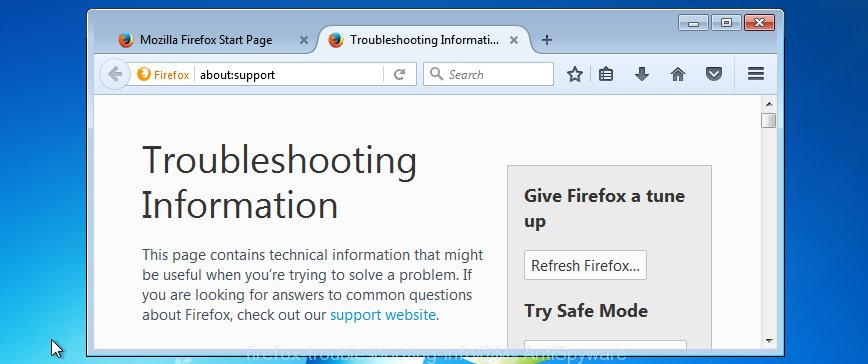
Click the “Refresh Firefox” button at the top right of the Troubleshooting Information page. Select “Refresh Firefox” in the confirmation prompt. The Mozilla Firefox will begin a process to fix your problems that caused by the OperativeDevice adware. When, it is done, click the “Finish” button.
Remove OperativeDevice adware from Google Chrome
If you are getting OperativeDevice ads, then you can try to delete it by resetting Chrome to its original state. It will also clear cookies, content and site data, temporary and cached data. However, your saved bookmarks and passwords will not be lost. This will not affect your history, passwords, bookmarks, and other saved data.
Open the Chrome menu by clicking on the button in the form of three horizontal dotes (![]() ). It will display the drop-down menu. Select More Tools, then click Extensions.
). It will display the drop-down menu. Select More Tools, then click Extensions.
Carefully browse through the list of installed addons. If the list has the add-on labeled with “Installed by enterprise policy” or “Installed by your administrator”, then complete the following instructions: Remove Google Chrome extensions installed by enterprise policy otherwise, just go to the step below.
Open the Chrome main menu again, press to “Settings” option.

Scroll down to the bottom of the page and click on the “Advanced” link. Now scroll down until the Reset settings section is visible, as shown in the following example and click the “Reset settings to their original defaults” button.

Confirm your action, click the “Reset” button.
Automatic Removal of OperativeDevice adware
Best OperativeDevice adware software removal tool should detect and remove adware, malware, potentially unwanted software, toolbars, browser hijacker infections, and pop up generators. The key is locating one with a good reputation and these features. Most quality programs listed below offer a free scan and malicious software removal so you can detect and remove undesired software without having to pay.
Run MalwareBytes to remove OperativeDevice
Manual OperativeDevice adware removal requires some computer skills. Some files that created by the adware can be not fully removed. We recommend that run the MalwareBytes Anti Malware (MBAM) that are completely free your computer of adware. Moreover, this free tool will help you to delete hijacker, malware, potentially unwanted software and toolbars that your MAC system can be infected too.
Visit the following page to download the latest version of MalwareBytes Anti Malware (MBAM) for Mac OS.
20945 downloads
Author: Malwarebytes
Category: Security tools
Update: September 10, 2020
After downloading is finished, close all windows on your machine. Further, launch the saved file. Follow the prompts.
The MalwareBytes will automatically start and you can see its main window as displayed below.
Next, click the “Scan Now” button for checking your MAC system for the OperativeDevice adware. Depending on your machine, the scan can take anywhere from a few minutes to close to an hour. While the MalwareBytes Anti Malware (MBAM) is checking, you may see number of objects it has identified either as being malware.

After MalwareBytes Free has completed scanning, you may check all items found on your MAC system. Review the results once the utility has complete the system scan. If you think an entry should not be quarantined, then uncheck it. Otherwise, simply press “Remove Selected Items” button.
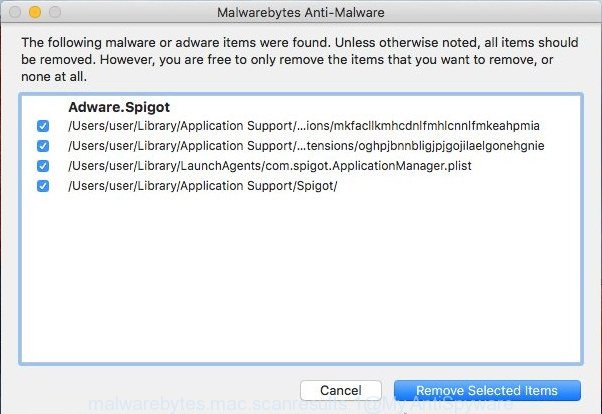
The MalwareBytes AntiMalware will remove OperativeDevice adware and move the selected items to the Quarantine.
How to stay safe online
If you browse the World Wide Web, you cannot avoid malvertising. But you can protect your browser against it. Download and run an ad-blocking program. AdGuard is an ad-blocker that can filter out lots of of the malvertising, stoping dynamic scripts from loading harmful content.

Download AdGuard on your MAC OS from the following link.
3754 downloads
Author: © Adguard
Category: Security tools
Update: January 17, 2018
After downloading is done, run the downloaded file. The “Setup Wizard” window will show up on the computer screen.
Follow the prompts. AdGuard will then be installed. A window will show up asking you to confirm that you want to see a quick instructions. Click “Skip” button to close the window and use the default settings, or press “Get Started” to see an quick instructions which will allow you get to know AdGuard better.
Each time, when you start your MAC system, AdGuard will launch automatically and stop annoying pop ups, block harmful and misleading web sites.
Finish words
Once you have complete the few simple steps shown above, your MAC OS should be clean from this adware and other malware. The Google Chrome, Safari and Mozilla Firefox will no longer display the OperativeDevice ads when you surf the Internet. Unfortunately, if the few simple steps does not help you, then you have caught a new adware software, and then the best way – ask for help.
Please create a new question by using the “Ask Question” button in the Questions and Answers. Try to give us some details about your problems, so we can try to help you more accurately. Wait for one of our trained “Security Team” or Site Administrator to provide you with knowledgeable assistance tailored to your problem with the OperativeDevice adware.

















